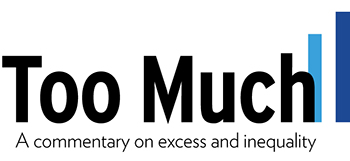Remember that $500,000 pay cap for bailed-out banking executives the White House announced back in February? Under Treasury Secretary Tim Geithner’s new rules for bailout pay, that maximum has become a minimum.
By Sam Pizzigati
Early this past February, amid escalating public fury over $165 million in bonuses at bailed-out insurance giant AIG, President Obama announced a $500,000 cap on executive cash compensation at bailed-out firms getting “exceptional assistance.”
Congress, feeling that same fury, would soon toughen limits on executive pay even more. Lawmakers banned executives — at any firm in TARP, the showcase bailout initiative — from taking in bonus dollars that equaled more than a third of their total compensation.
And then executive pay proceeded to drop off the political radar screen — until last week when Treasury Secretary Timothy Geithner unveiled the long-awaited new rules meant to clarify just how much executives can make when tax dollars are keeping their companies afloat.
Secretary Geithner’s answer: They can make plenty.
“We are not capping pay,” the secretary told reporters Wednesday.
 Geithner’s new directives essentially erase the executive pay cap President Obama announced in February. Geithner’s new rules, in effect, turn that $500,000 maximum into a minimum.
Geithner’s new directives essentially erase the executive pay cap President Obama announced in February. Geithner’s new rules, in effect, turn that $500,000 maximum into a minimum.
Under these rules, a new federal pay czar will “automatically approve” any pay package the nation’s most troubled enterprises dish out that doesn’t top half a million.
How high above this half million can these pay packages now go? The original White House $500,000 cap on cash compensation did allow execs to collect additional stock awards, on an unlimited basis, so long as they didn’t cash those awards out until their firms had paid back their bailouts.
But the bonus restriction that Congress then passed — limiting bonuses to one-third of total pay — effectively placed a lid on these additional awards at $250,000, a figure that would translate into one-third of total pay if cash compensation were limited to $500,000.
The new regs Geithner released last week knock this lid off. They turn full responsibility for executive pay at firms now getting “exceptional assistance” — a group that now includes AIG, Citigroup, Bank of America, Chrysler, GM, GMAC, and Chrysler Financial — over to a new pay czar, Washington superlawyer Kenneth Feinberg.
Feinberg, for his part, spent last week reassuring Wall Street how reasonable his pay judgments will be. He even urged reporters not to call him a “czar.”
“It makes it sound as if my goal is to impose certain restrictions on the private marketplace,” Feinberg explained, “whereas I am much more interested in working with these companies.”
And those companies seem eager to work with him. Top corporate execs, the Washington Post reports, “breathed a sigh of relief” Thursday after going over the details in the Geithner pay package. They found little reason, as one top New York executive compensation consultant told a Bloomberg reporter, “to be prepared for less pay.”
The new Geithner executive comp package has something for everyone.
The biggest bailout basket cases now have no pay cap and more wiggle room. The pay czar will be reviewing and approving their proposed executive pay levels under “principles” that allow the basket cases to argue that they need to pay princely sums to remain competitive.
Beyond the basket cases, in the much larger universe of TARP recipients, the Treasury Department has thoughtfully excluded a variety of revenue streams from regulation. Investment managers who get to pocket a percentage of the assets they manage, for instance, don’t have to worry about any bonus limits kicking in, no matter how grand the assets grow.
TARP recipients do face some new rules that prohibit some commonplace executive pocket-stuffing practices. One example: Firms can no longer reimburse their executives for the taxes the execs owe on their perks like free country club memberships, a practice known as “grossing up.”
But TARP recipients can increase regular executive cash compensation to offset the shortfalls these new prohibitions create, and the higher this cash compensation goes, the more firms can shell out in bonuses and still meet the bonus-as-one-third-of-total-pay limit that Congress set.
And the big banks that have paid off their TARP dollars? These kingpins — the likes of Goldman Sachs, JPMorgan Chase, and Morgan Stanley — get the best deal at all. They face no compensation limits whatsoever.
Yet these financial giants are still receiving government aid, most notably via FDIC loan guarantees. These guarantees have enabled the ten banks that exited TARP last week to borrow $57.8 billion at lower-than-market interest rates. These interest rate savings, in turn, are pumping up the banks’ bottom lines — and the “performance” bonuses due their heaviest of hitters.
“Our financial system,” Secretary Geithner noted last week, “is built on trust and confidence.”
The superstars of that system, now more than ever, have every reason to confidently trust in Secretary Geithner.
Sam Pizzigati edits Too Much, the online weekly on excess and inequality.



Discussion
No comments for “Making Wall Street Safe for Windfalls”